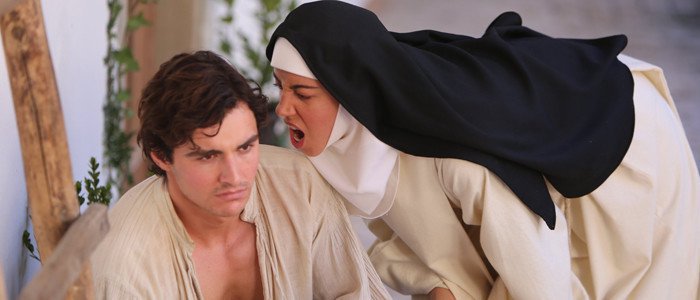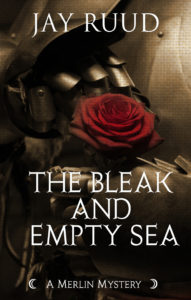The Little Hours
Dan Baena (2017)
[av_image src=’http://jayruud.com/wp-content/uploads/2014/09/SusannTennyson.jpg’ attachment=313′ attachment_size=’square’ align=’left’ animation=’left-to-right’ link=” target=” styling=” caption=’yes’ font_size=” appearance=’on-hover’]
[av_textblock size=” font_color=” color=”]
The closest thing to Jeff Baena’s film of The Little Hours that you’re likely to have seen is Monty Python and the Holy Grail. Both films set their stories in the Middle Ages, both burlesque the period with some fairly contemporary jokes and sensibilities, and both provide not so much a unified story arc as a series of comedy sketches reminiscent of Monty Python’s Flying Circus or Saturday Night Live. This is not surprising considering the fact that Holy Grail featured the creators of Flying Circus, and Little Hours stars a number of veterans of TV sitcoms like Parks and Recreation, Community, The Big Bang Theory, and yes, Saturday Night Live. But actually, the similarity stops there, in that Python’s Terry Jones, codirector and, of course, cowriter of Holy Grail, is a serious (if iconoclastic) scholar of medieval history, while Baena (Life After Beth) and his collaborators seem to have little actual knowledge of the period (as a bizarre witch’s coven scene late in the film makes clear) or of nuns in general (as the fact that one of the nuns in the film, presumably one who has taken her vows since she’s not presented as a postulant but as a full member of her order, is waiting for her father to arrange a marriage for her so she can leave the convent and get married, clearly indicate).
It’s wild gaffes like these that keep the film from being a reasonably faithful dramatization of its chief source, Boccaccio’s Decameron. The Decameron, or the hundred stories, is a collection of tales within a frame tale in which ten young Florentine aristocrats flee the Black Death in Florence, spending ten days at a country estate where they take turns telling stories to one another, each of the ten telling one story a day. Hence, a hundred stories. For the outline of his plot, Baena has taken the first and second stories of the third day from Boccaccio’s text. In the original, the first story of the third day tells of a young man who, in order to get a job as a gardener at a convent somewhere in the Tuscan countryside, pretends to be a deaf mute. The sexually frustrated nuns, believing that the young gardener can never tell anyone, all end up coming to be sexually serviced by him regularly. When the abbess herself begins to monopolize his services, it is too much for him and he has to tell her to stop, claiming that he’s been miraculously cured of his inability to speak.
The second story of the third day involves a groom who works for a certain king, and who slips into the queen’s bed pretending to be her husband. When the king discovers what has happened, he visits the grooms’ quarters, where they all sleep in the same room, and feels the heartbeat of each sleeping figure, knowing that the guilty party’s heart will still be beating fast from his recent exertions. He finds the culprit by his heartbeat and, in order to keep his cuckolding a secret, resolves to deal with the guilty groom later, and cuts a forelock from the guilty man’s hair before leaving the chamber. But once the king has left, the clever culprit goes around and similarly cuts a forelock from the head of every groom in the place, so that in the morning the king is not able to tell who the guilty party is.
Baena takes these two tales and mashes them together, so that the groom who cuckolded his lord becomes the young man who poses as a deaf mute in the convent, which he does in order to hide from his master who has finally discovered who cuckolded him. Boccaccio’s tales are a form of story called a fabliau, popular in the later Middle Ages in France and later in Italy and in England. Students of English literature may be most familiar with Chaucer’s Miller’s Tale, the most famous and celebrated fabliau in English. But Chaucer himself was inspired by Boccaccio, and while the Decameron (like the Canterbury Tales) contains tales of every genre popular in the Middle Ages—romances, saints’ lives, tragic stories, folk legends—it also contains a significant number of these fabliaux. Fabliaux are characterized typically by a few basic criteria: First, there is almost always some illicit sexual encounter, most often one that involves a member of the clergy or someone in holy orders. Second, the world of the fabliau is a world in which characters’ motivations tend to be far from noble: Innocence and gullibility are the greatest sins of the fabliau world, and are usually punished severely in the course of the action, while cleverness, aggression and self-interest tend to thrive. Third, the action of the fabliau is usually set in motion by some trickster who, ultimately, is tricked himself, so that the plot of the fabliau is the “trickster tricked.” What goes around comes around is the basic structure of a fabliau. This is not so much the way that Baena structures the story.
In The Little Hours, the nuns Alessandra (Alison Brie of Community and Mad Men), Fernanda (Aubrey Plaza of Parks and Recreation) and Ginerva (Kat Micucci of The Big Bang Theory) are all pretty uncomfortable in their vocation, and spend their time gossiping and complaining about each other and about the convent’s hired laborer, who ultimately quits because of their abuse. Meanwhile, Massetto (Dave Franco of Scrubs), groom to the grumbling tyrant Lord Bruno (Nick Offerman, Plaza’s co-star from Parks and Recreation), is having a vigorous affair with Bruno’s far-from-unwilling wife Francesca (a hilarious Lauren Weedman from TV’s Looking). When Bruno finds out, Massetto is forced to flee, and after he helps the nun’s confessor, a drunken Father Tommasso (John C. Reilly), the good father invites him to become the new laborer at the convent. They agree, however, that Tommasso should pretend to be a deaf mute, to prevent the nuns abusing him as they did their previous laborer. Well, needless to say, the deaf-mute thing doesn’t exactly discourage the sexually repressed sisters from abusing Tommasso one way or another. Meantime Father Tommasso seems to be having his own way with the abbess, Sister Marea (Molly Shannon from Saturday Night Live). When the convent gets a surprise visit from the bishop (Fred Armisen, another SNL alumnus), everything comes crashing down.
The film has a casual air to it, a feeling that this is a kind of lark that a bunch of pals got together and decided to make. The fact that Baena and Plaza (credited as the film’s producer) are married, as are Brie and Franco, and that several of the actors have worked together before on TV or in Baena’s previous film Life After Beth, adds to this perception. In particular, the fact that there was no script for the film, just a twenty-page plot outline, which meant that all of the dialogue essentially had to be improvised, underscores that casual “let’s put on a show” feel. This latter fact explains the initial jarring discrepancy between the period-costume setting and the characters’ contemporary language and vocabulary. But once we get over the anachronistic humor of medieval Italian nuns dropping the F-bomb so casually, the linguistic humor fades, and we are left with the fact that the improvised dialogue is not particularly snappy or clever.
Some of the changes Baena makes from Boccaccio work, and some don’t. The whole pagan witch’s midnight Sabbath scene lacks humor or any particular point as far as the film’s plot is concerned, but seems only a gratuitous opportunity in which to have the women leap about in the dark stark naked. The story of Massetto and the nuns is actually funnier in Boccaccio than it is here, but the relationship between the priest and the abbess introduces a tender element, foreign to the rough and tumble fabliau world of Boccaccio, that makes for a more meaningful film after all. When Father Tommasso tells Sister Marea “that monastery is so boring, all we do is pray! I mean, it is important, but …,” the film takes a turn into some sort of actual thematic commentary about the need to find the sacred in the secular world.
Shot on location in Tuscany, the film is pretty to look at, and Dan Romer’s score may be the best thing about the movie: Its lively choral arrangements and ancient-sounding tunes do as much to create a late medieval atmosphere as the costumes and scenery do.
There have been a number of Catholic-affiliated protests of this film, mainly online, but these seem to me to be unnecessary. Any harm The Little Hours may do to the Church is negligible compared to what films like 2015’s Spotlight have already done. The Little Hours does no more than Boccaccio or Chaucer did more than 600 years ago: point out that for whatever reason, there are various people in religious vocations who should never have entered them. But the onus is on those people, not the Church itself. It’s actually Father Tommasso’s implication that prayer is important, but there are other important things in life, that does the most in this film to undercut the Church’s ideal of cloistered religiosity, but that mild comment is the least likely thing about the film that folks will find objectionable.
In the end, there may be more positives than negatives about this movie, but just barely. I’ll give it two Jacqueline Susanns and half a Tennyson.
And by the way, if you like reading these reviews, you might be interested in Jay Ruud’s new “Merlin Mystery” novel, the third in the series, which will be released on November 10 and now available for pre-ordering on Amazon and on Barnes and Noble:
When word comes to Camelot that Sir Tristram has died in Brittany of wounds suffered in a skirmish, and that his longtime mistress, La Belle Isolde, Queen of Cornwall, has subsequently died herself of a broken heart, Queen Guinevere and her trusted lady Rosemounde immediately suspect that there is more to the story of the lovers’ deaths than they are being told. It is up to Merlin and his faithful assistant, Gildas of Cornwall, to find the truth behind the myths and half-truths surrounding these untimely deaths. By the time they are finally able to uncover the truth, Gildas and Merlin have lost one companion and are in danger of losing their own lives.
Pre-order from Amazon here: https://www.amazon.com/Bleak-Empty-Sea-Tristram-Mystery/dp/1893035735/ref=sr_1_1?s=books&ie=UTF8&qid=1503328086&sr=1-1&keywords=Bleak+and+Empty+Sea
Tramadol Online Prices Pre-order from Barnes and Noble here: https://www.barnesandnoble.com/w/the-bleak-and-empty-sea-jay-ruud/1126958139?ean=9781893035737


